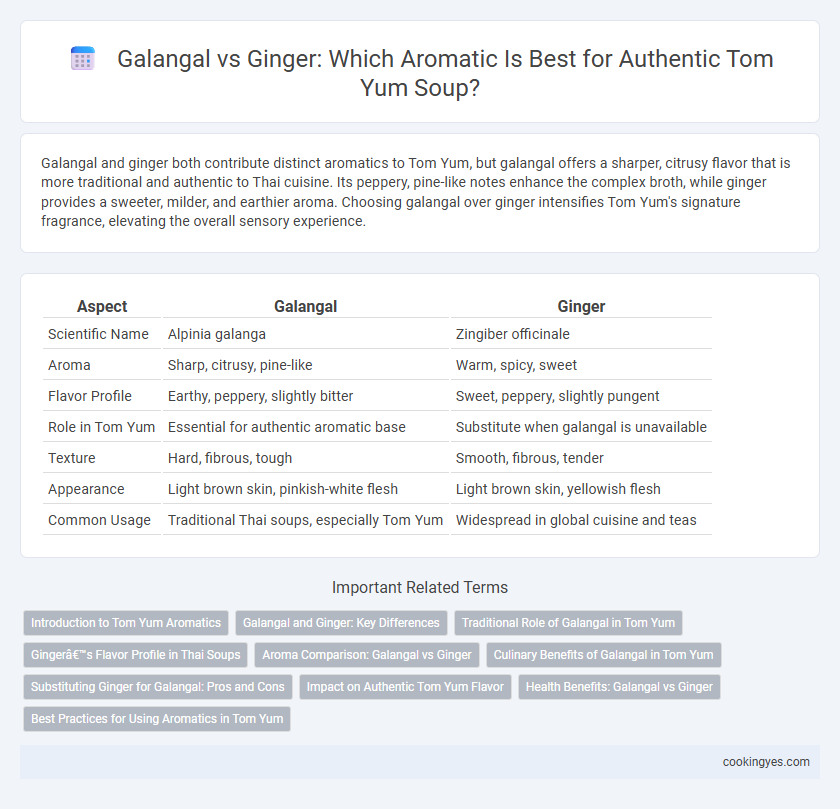Galangal and ginger both contribute distinct aromatics to Tom Yum, but galangal offers a sharper, citrusy flavor that is more traditional and authentic to Thai cuisine. Its peppery, pine-like notes enhance the complex broth, while ginger provides a sweeter, milder, and earthier aroma. Choosing galangal over ginger intensifies Tom Yum's signature fragrance, elevating the overall sensory experience.
Table of Comparison
| Aspect | Galangal | Ginger |
|---|---|---|
| Scientific Name | Alpinia galanga | Zingiber officinale |
| Aroma | Sharp, citrusy, pine-like | Warm, spicy, sweet |
| Flavor Profile | Earthy, peppery, slightly bitter | Sweet, peppery, slightly pungent |
| Role in Tom Yum | Essential for authentic aromatic base | Substitute when galangal is unavailable |
| Texture | Hard, fibrous, tough | Smooth, fibrous, tender |
| Appearance | Light brown skin, pinkish-white flesh | Light brown skin, yellowish flesh |
| Common Usage | Traditional Thai soups, especially Tom Yum | Widespread in global cuisine and teas |
Introduction to Tom Yum Aromatics
Galangal and ginger are essential roots in crafting Tom Yum's distinctive aromatic profile, each contributing unique flavors that shape the soup's character. Galangal offers a sharp, citrusy, and pine-like essence fundamental to traditional Thai cuisine, distinguishing Tom Yum from other dishes. Ginger imparts a warm, spicy undertone but lacks the bright, fragrant notes galangal provides, making galangal the preferred choice for authentic Tom Yum aromatics.
Galangal and Ginger: Key Differences
Galangal and ginger are essential aromatics in Tom Yum, with galangal offering a sharp, citrusy flavor that enhances the soup's distinctive taste, while ginger provides a milder, slightly sweet warmth. Galangal's fibrous texture compared to ginger's softer consistency affects the infusion process, making galangal more resilient during simmering. The unique bioactive compounds in galangal, such as galangin, contribute to its aromatic complexity and health benefits, setting it apart from ginger's gingerol-based profile.
Traditional Role of Galangal in Tom Yum
Galangal, a rhizome native to Southeast Asia, is a cornerstone in traditional Tom Yum recipes, offering a sharp, citrusy aroma that ginger cannot replicate. Its unique essential oils provide a distinctive, peppery heat and subtle pine-like fragrance, essential for achieving the authentic balance of flavors in Tom Yum broth. While ginger is milder and sweeter, galangal's robust, aromatic profile remains indispensable for maintaining the soup's signature character and depth.
Ginger’s Flavor Profile in Thai Soups
Ginger contributes a warm, spicy, and slightly sweet flavor to Tom Yum, enhancing the soup's complex aromatic profile with its subtle peppery notes. Unlike galangal, which has a sharp, citrusy, and pine-like taste, ginger provides a smoother and earthier undertone, balancing the sour and spicy elements typical in Thai soups. Its distinctive zing heightens the overall depth and freshness, making ginger a versatile choice for enriching Tom Yum's traditional flavor layers.
Aroma Comparison: Galangal vs Ginger
Galangal imparts a sharp, citrusy, and pine-like aroma to Tom Yum, creating a distinct and authentic fragrance crucial for traditional recipes. In contrast, ginger offers a warmer, sweeter, and earthier scent that softens the soup's aromatic profile but lacks galangal's crisp intensity. The choice between galangal and ginger significantly affects the aromatic complexity and flavor authenticity of Tom Yum.
Culinary Benefits of Galangal in Tom Yum
Galangal delivers a sharp, citrusy flavor with a hint of pine that enhances the complex aromatics of Tom Yum, driving its signature bright and refreshing profile. Unlike ginger, galangal's woody texture and unique essential oils provide a deeper, more pungent aroma that complements the lemongrass and kaffir lime leaves essential to authentic Tom Yum soup. Its culinary benefits include adding layers of flavor complexity and balancing the sour and spicy elements, making the broth richer and more aromatic.
Substituting Ginger for Galangal: Pros and Cons
Substituting ginger for galangal in Tom Yum alters its authentic flavor profile, as galangal provides a sharper, citrusy aroma while ginger is milder and sweeter. Using ginger can make the broth more accessible and slightly sweeter, but it lacks the complex pine-like notes essential to traditional Tom Yum. This substitution benefits those seeking a readily available ingredient without significantly compromising the dish's bright, spicy character.
Impact on Authentic Tom Yum Flavor
Galangal is essential for authentic Tom Yum flavor, offering a sharp, citrusy aroma and a slightly pine-like taste that defines the soup's unique character. Ginger, while spicy and warming, lacks galangal's distinctive brightness and can overpower the delicate balance of herbs traditionally used in Tom Yum. Using galangal preserves the classic Thai aromatic profile, ensuring the soup retains its signature tangy and fragrant taste.
Health Benefits: Galangal vs Ginger
Galangal and ginger, both essential aromatics in Tom Yum, offer distinct health benefits: galangal is rich in antioxidants and possesses strong anti-inflammatory and antimicrobial properties, aiding digestion and immune support. Ginger also provides anti-inflammatory effects, reduces nausea, and improves cardiovascular health but has a milder, sweeter aroma compared to galangal's sharp, citrusy notes. Incorporating galangal enhances Tom Yum's medicinal value by targeting digestive issues and infections more robustly than ginger.
Best Practices for Using Aromatics in Tom Yum
Galangal imparts a sharp, citrusy, and pine-like aroma that defines authentic Tom Yum broth, while ginger offers a milder, sweeter spice that can soften the soup's intensity. For best practice, slice fresh galangal thinly to maximize its fragrant oils without overpowering, ensuring it simmers with kaffir lime leaves and lemongrass for balanced aromatics. Using fresh galangal rather than dried or powdered guarantees the signature bright and complex flavor profile essential to traditional Tom Yum.
Galangal vs Ginger for Tom Yum aromatics Infographic

 cookingyes.com
cookingyes.com